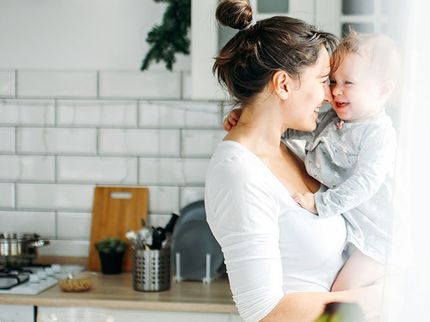Bioplastics make packaging more sustainable
Market launch of innovative packaging that reduces food and packaging waste
Advertisement
In the 27 European countries, not only are 89 million tonnes of food thrown away every year - packaging waste is also produced in tonnes. This trend is being countered by a European research project: In the MyPack project, the participating researchers and companies are driving forward the market launch of innovative and sustainable packaging based on renewable raw materials in order to reduce the waste of food and packaging materials. At the University of Hohenheim in Stuttgart, the Research Centre for Bioeconomy led by Susanne Braun and the Department of Conversion Technologies of Renewable Raw Materials led by Prof. Dr. Andrea Kruse are involved in MyPack: With a funding of more than 430,000 euros, the project is one of the major research priorities at the University of Hohenheim.
The invention of plastics has changed our world. But not only for the good: plastics can also be found where they have no place - as floating islands in the sea or as microplastics in our food. But it's not only plastics that end up in the trash, food also ends up in tons of waste. This is not only a waste of resources, but also increasingly burdens people and the environment.
This is why the MyPack research project has set itself the goal of supporting the market launch of innovative packaging in order to reduce both food and packaging waste and its negative impact on the environment. The focus is on biodegradable and compostable packaging, packaging made from renewable raw materials, or special packaging that extends the shelf life of food products, for example by reducing air permeability.
There is a wide range of applications - from packaging for ready-to-use sliced salad to the production of trays for baby food. But the researchers are not only investigating the environmental impact and industrial feasibility, but also consumer acceptance.
Green plastics alternatives
At the University of Hohenheim, Prof. Dr. Andrea Kruse's Department of Conversion Technologies of Renewable Raw Materials is working on the topic of what alternatives there are to conventional raw materials. Doctoral student Markus Götz from her team explains the approach: "We are looking for alternative packaging solutions that ensure that food stays fresh and durable for longer so that less has to be thrown away.
"In doing so, we support companies that want to make greater use of materials from renewable raw materials and help with the evaluation. Unfortunately, these biobased plastics currently still account for an insignificant proportion of global plastics production. Most of the plastics currently on the market are made from crude oil," he continues.
PEF instead of PET: One hundred percent renewable and recyclable
PET (polyethylene terephthalate), a plastic that is often used for drinks bottles and other food packaging, is also produced from crude oil. "The aim is to replace the 'T' in PET as far as possible with an 'F', where the 'F' stands for 'furan dicarboxylic acid'. A precursor of this, hydroxymethylfurfural (HMF), can be obtained from chicory root beets, for example, which otherwise end up unused as waste in compost or in the biogas plant," Markus Götz continues. Other carbohydrate-containing waste from forestry and agriculture can also be used. This also prevents competition with food production.
PEF can therefore be produced one hundred percent from renewable raw materials. At the same time, it has no worse properties than petroleum-based PET. On the contrary: bio-based PEF has a higher gas barrier than PET, i.e. it prevents oxygen from penetrating into the food much better, which significantly increases the shelf life of meat, for example. Conversely, in the case of carbonated beverages, the gas remains longer in the bottle if it is made of PEF.
In addition, the higher mechanical stability of PEF allows the use of thinner films and packaging. For example, bottles made of PEF can have a significantly thinner wall thickness than PET bottles. This reduces not only material costs but also transport costs.
Currently, the biggest hurdle for industrial use is still the lack of availability of this material. But Markus Götz can counter reservations about the recyclability of PEF: "PEF is so chemically similar to PET that both materials can be recycled together. There is no need for any complicated separation beforehand".
PLA and PEF: Strong in combination
What is still largely a pipe dream for PEF is already a reality for another bio-plastic: PLA (polylactic acid), an abbreviation for polylactic acid, is already frequently used by retailers for food packaging. Just like PEF, PLA is produced from one hundred percent renewable resources. It is based on corn starch, which is chemically or biologically converted into lactic acid. However, the high water vapour permeability of PLA limits its possible applications in the food sector.
"In MyPack we have succeeded in producing a composite film made of PLA and PEF," explains Markus Götz. "This combines the barrier properties of PEF with the comparatively low price of established PLA. This combines the positive properties of both polymers. This can accelerate the market launch of PEF, as the high costs are currently one of the biggest barriers to market entry".
The composite film is even superior to comparable conventional plastics: With the same barrier properties it can even be 30 percent thinner and thus lighter. "This reduces the amount of material used, transport costs and thus also the environmental impact," says Markus Götz.
Market entry barriers are also included
But for bioplastics to gain a foothold in the market, the barriers that hinder market entry must first be identified. The Hohenheim Research Centre for Bioeconomy has set itself this task - together with other project partners such as the bioplastics producer Novamont and the European Society for the Testing of Packaging Recycling.
"We need to identify the key drivers in the biopolymer industry and describe the legal environment and regulatory framework," explains Susanne Braun, head of the Research Centre for Bioeconomy. "We are also analysing the potential applications of biodegradable and compostable materials at the end of their life cycle." In cooperation with several partners from the consortium, Tetiana Pavlenko from the Research Centre for Bioeconomy has summarised the specifications that should lead to important guidelines for the market introduction of new packaging technologies.
Furthermore, new packaging materials can only be successful on the market if they are accepted by consumers. For this reason, a sub-project of MyPack deals with the different expectations that different consumer groups have of the sustainability, handling, safety and quality of the product. Wageningen University is investigating this aspect. It determines the market opportunities at consumer level for more sustainable product packaging. It takes into account different consumer segments, product categories, packaging solutions and local contexts.
BACKGROUND: MyPack
The aim of the EU project "Best markets for the exploitation of innovative sustainable food packaging solutions" (MyPack) is to help sustainable food packaging technologies enter or expand their market.
MyPack is coordinated by ACTIA (Association de coordination technique pour l'industrie agroalimentaire), the French technical coordination association for the food industry. The consortium consists of 18 partners from 6 different countries. Research and science work closely with industry, especially small and medium-sized enterprises.
MyPack started on 1.11.2017 and will run until 30.4.2021. The European Union is supporting the project through the Horizon 2020 framework programme with a total of almost 5 million euros, of which 431,725 euros are being provided by the University of Hohenheim. This makes it one of the heavyweights in research.

Unijewels / Pixabay
Note: This article has been translated using a computer system without human intervention. LUMITOS offers these automatic translations to present a wider range of current news. Since this article has been translated with automatic translation, it is possible that it contains errors in vocabulary, syntax or grammar. The original article in German can be found here.




























































